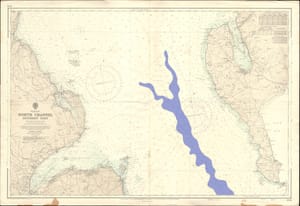First, thanks to everyone who sent notes after yesterday's newsletter. I love you too 💞
SCOPE CREEP.
- The United Kingdom has implemented a new "hierarchy of responsibility" for users of public roads. As described in the video here, "those in charge of vehicles that can cause the greatest harm bear the greatest responsibility to take care and reduce the danger they pose to others." This is almost exactly what I was arguing for in 2021, when I wrote about the right of way system established in 72 COLREGS, the international rules of the maritime road:
Life at sea is too complex to be bogged down in minutiae. In order to survive there, humans have created logical frameworks for behavior—ones which usually fall back to something like “stay away from boats that look like they might have a hard time staying away from you.” They are expressions of ethics and common sense: it would be wrong for a motorboat to run over a canoe, and it would be wrong for a pleasure yacht to play chicken with an oil tanker. Rule 18 reflects that.
Of course, life in and around automobiles is too complex to be bogged down in minutiae too... And yet we do a terrible job encoding our ethics into our traffic laws.
- A good, short biography of Dwight Smith Young, a "a maintenance man at a box factory" who, during the Great Depression, got a job working for Enrico Fermi in the Met Lab. Young, who had not gone to college, ended up moving to Los Alamos and working on the Manhattan Project. He witnessed the Trinity Test as a flash in the sky after having walked for twelve hours from Los Alamos to Santa Fe, and he was standing behind Louis Slotin when the plutonium "Demon Core" went critical and released (to Slotin) a fatal dose of radiation. Young blamed General Leslie Groves (Matt Damon's character in Oppenheimer) for Slotin's death; he went on (still as a technician, rather than a full staff member) to develop the first breeder reactor out of spare parts.
- The Millersburg Ferry crosses the Susquehanna River a little upstream of Harrisburg, Pennsylvania. When it was established, in the mid-eighteenth century, it operated as a pole ferry, but in 1873 a dam was built downstream of the ferry such that the water level would be sufficient for a steam-powered paddle wheel boat. Since then, many bridges have been built across the Susquehanna (which is about a mile wide at Millersburg), but the ferry continues to operate and is the only way to cross its particular forty-mile section of river. The steam engines are now long gone, but the ferry still uses wooden-hulled, paddle wheel boats, one of which was built in 1917. "The Ferry does not run on a set schedule, but as traffic warrants and water levels allow" between May and mid-October. Sign me up.
- Apropos of whether hot dogs are sandwiches, I wanted to bring to your attention the cube rule of food identification, a pedantic and fun way to ensure that nobody understands what you're talking about.
- From Greg Koenig on Twitter, a pretty good anecdote/explanation for why AN series bolts cost so much. I'm a little surprised that the threads on the bolts in question would be cut rather than rolled (at least some AN series bolts have rolled aka pressed aka forged threads), and I struck out trying to actually find a copy of the spec (partly because the "AN" part is so hard to Google), but Greg did add some additional points about the disadvantages of rolled threads in a subsequent reply.
Related, here's a very thorough StackExchange thread showing exploded, cross-sectional, and photographic images of how aircraft engines are bolted (and shear-pinned) to the wings of commercial jets.
And, (morbidly) related: The most deadly aviation accident that occurred in the US is American Airlines 191, in which a McDonnell Douglas DC-10 taking off from O'Hare suddenly had its left engine detach from the wing. The event was of course horrible, but the aerodynamics at play are insane. From Mara Vatz's 2004 Masters Thesis analysis of the crash:
Robert J. Graham, a supervisor of production control and aircraft maintenance for American Airlines, had perhaps the best vantage point. He was waiting to cross the runway in his van as Flight 191 accelerated towards him. He told the investigators what he saw: "As the aircraft got closer," he said, "I noticed what appeared to be vapor or smoke of some type coming from the leading edge of the wing and the No. 1 engine pylon. I noticed that the No. 1 engine was bouncing up and down quite a bit, and just about the time the aircraft got opposite my position and started rotation, the engine came off, went up over the top of the wing, and rolled back down onto the runway."
Before it went over the wing, he said, the engine went forward and up, "just as if it had lift and was actually climbing." It didn't strike the top of the wing on it's way. Rather, it followed the clear path of the air flow of the wing, up and over the top of it, then down below the tail.
Graham continued to watch the plane as it climbed a "fairly normal climb, until it started a turn to the left. And at that point, I thought he was going to come back to the airport."
- From George Cave, a pretty cool reflection (with awesome photography) on a more than ten-year-old experience researching how meltwater flows underneath the Greenland Ice Sheet.

Read the full story
The rest of this post is for paid members only. Sign up now to read the full post — and all of Scope of Work’s other paid posts.
Sign up now
Already have an account?
Sign in


